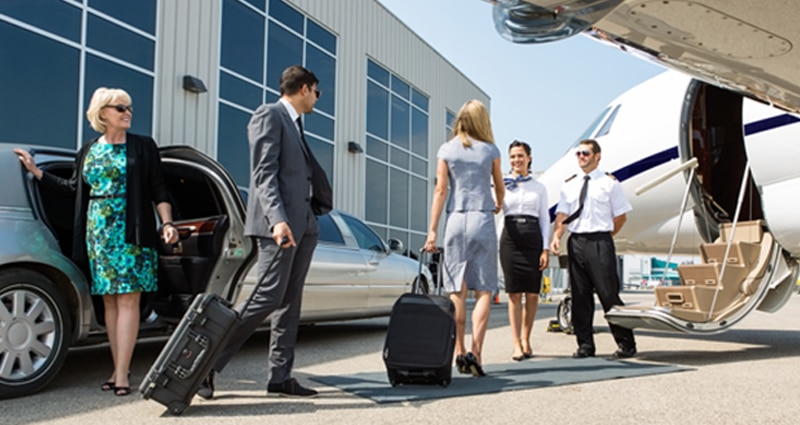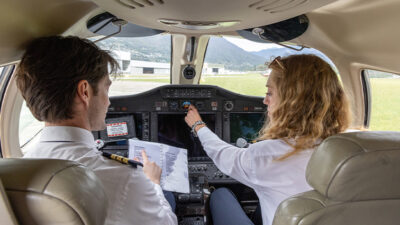OSHA Update at a Glance: Workplace Safety & Cabin Crew

Enhancing Safety & Well-Being Through Training & Prevention
In 2013, the Federal Aviation Administration (FAA) released a Policy Statement to enhance occupational safety and health in the aircraft cabin by establishing the extent to which Occupational Safety and Health Administration (OSHA) standards apply to the working conditions of aircraft cabin crew members while they are onboard aircraft in operation.
The Policy Statement identified three areas in which requirements of the Occupational Safety and Health Administration may be applied to crew members while working in an aircraft: Hazard Communication, Bloodborne Pathogens standards and Hearing Conservation standards.
Who: Defining Cabin Crew
Part 135 air charter, part 121 operators, and Part 91 corporate flight operators operating business aircraft in the United States that utilize at least one aircraft cabin crew member are advised to review the Policy Statement and work with their cabin training providers to ensure these topics are incorporated in their training curriculum.
The Policy Statement from the FAA defines a cabin crew member as a person assigned to perform duty in an aircraft cabin when the aircraft is in operation (other than flight crew members).
With this definition, MedAire recommends all cabin crew members, as well as maintenance personnel and flight technicians who may fly with the aircraft, participate in cabin crew training for Hazard Communications, Bloodborne Pathogens and Hearing Conservation.
“Prevention is key to reducing occupational-related injuries and exposure to hazards found in the aviation environment,” says Paulo Alves, Global Medical Director of Aviation Health at MedAire. “Education is a major component to creating a safer workplace.”
A Few Quick Wins Toward Compliance
Hearing Conservation: Make ear plugs and ear muffs available to crew when appropriate. The most important thing is that the equipment is used according to company policy. Provide crew the choice so they will use what is most comfortable to them.
Bloodborne Pathogens: Accidental puncture from needles used during medical events or self-administered by passengers and improperly disposed are a risk to cabin crew. Training crew on how to manage potentially infected material is the most effective way to reduce risk. MedAire students learn about bloodborne pathogens, as well as other infectious diseases, prevention tactics, and the proper use of personal protection equipment.
Hazard Communications: Train crew on protection practices, procedures and equipment to use when handling hazardous chemicals in the workplace.
Get Started
- Understand the health risks associated with and in your workplace
- Determine what proactive measures are necessary for your environment
- Understand company policies and procedures associated with workplace safety
- Raise cabin crew member awareness
- Provide training that is relevant to the aviation environment
- Implement robust prevention programs
Learn More
Read the Policy Statement: Occupational Safety and Health Standards for Aircraft Cabin Crew Members
Visit OSHA online at www.osha.gov
Review hazard communications resources at www.osha.gov/dsg/hazcom
Contact MedAire. Call 480-333-3700. Email Javascript must be enabled to see email addresses.
Request information on programs: www.medaire.com/bga_training

Flight departments around the world rely on MedAire, an International SOS company, to reduce their travel safety risks. Crews are trained on the resources to manage in-flight illness and injury with onboard medical equipment and telemedicine assistance. On the ground, passengers and crew have one resource for medical referrals; guaranteed payments for medical expenses; assistance with lost documents and prescriptions; online and e-mail travel advisories; evacuation support and a host of other services.
http://www.medaire.com/
© 2024 MedAire. All Rights Reserved.
Next ArticleRelated Posts

Safety in Numbers: Trends in Aviation Accidents and Incidents
Every accident is preventable; the problem is that we don’t know how to prevent it until after the accident happens. However, what we can do as an industry is honor the anguish of each event by sharing the information, the mistakes and the outcomes to improve safety for everyone.

The Flip Side of Psychological Safety
From a human factors perspective, we might be evolving towards a partial power situation. In the evolving landscape of workplace dynamics in pursuit of improved safety, the concept of psychological safety has gained significant traction. It’s the bedrock of an organizational culture that fosters open communication, innovation, and growth.

